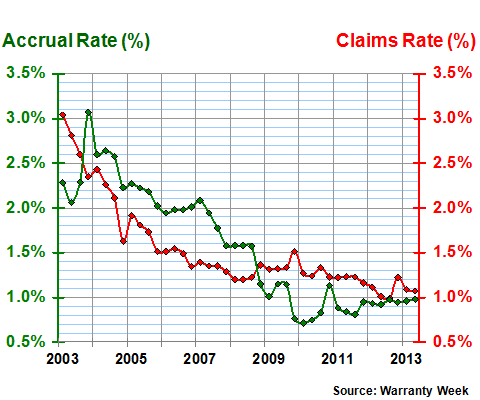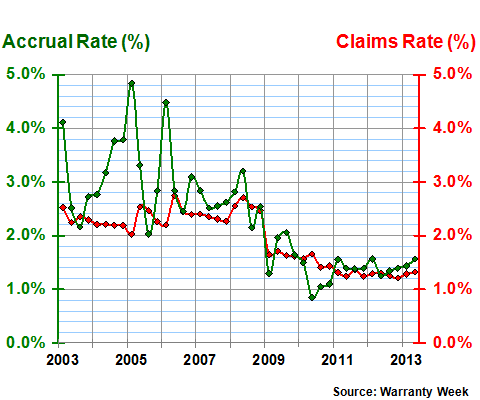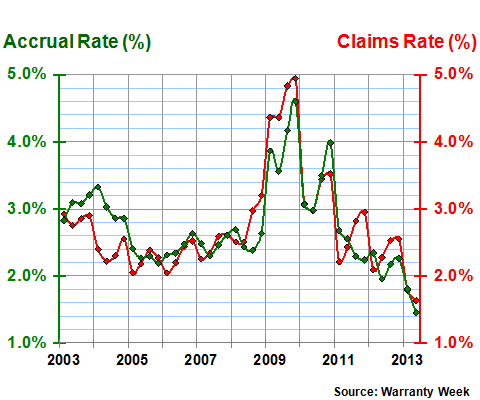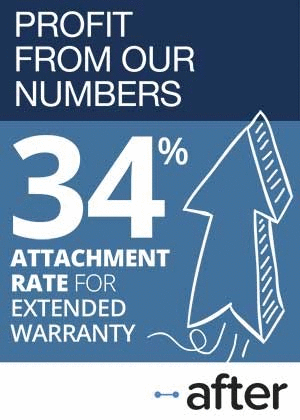Warranty Cost Reduction:Billions of dollars have been saved in the past decade as American manufacturers find ways to reduce their warranty expenses. Now we're naming names and showing the decline in charts that measure warranty expenses as a percentage of product sales.
Want some good news? Product quality is rising, warranty expenses are falling, and advanced technology and management techniques are helping manufacturers cut their warranty expenses to their lowest level ever.
At the beginning of 2003, when little was known about warranty costs across companies and industries, American manufacturers spent an average of 1.8% of their product revenue on warranty claims. Last year, that average was closer to 1.3%, and that 500-basis-point decline suggests that billions of dollars have been cut from warranty budgets over the past decade.
Last week we used charts to identify eight "manufacturing excursions," most of which were only lightly mentioned in financial reports, and some of which were not mentioned at all. This week, we're combing through the charts to identify nine successful warranty cost-cutters.
We looked at all manufacturers reporting claims payments of $5 million or more in 2012 and identified nine with declining multi-year warranty expense rates. Many more had declines here and there, but these are the long-term winners -- the companies that are making it last.
Large Manufacturers
We could have easily gone to a dozen companies, but we've already spotlighted the success of cost-cutters such as Ford Motor Co. and General Motors Co., which reduced their warranty outlays by literally billions of dollars over the past few years. But they're not the only large manufacturers enjoying the savings. Here are the warranty charts for five very large and four more somewhat large manufacturers from a diverse mix of industries.
Let's start with United Technologies Corp. The conglomerate spans the HVAC industry (Carrier), aviation (Pratt & Whitney, Sikorsky, and Hamilton Sundstrand), and building materials (Otis Elevator). It paid out $277 million in claims last year, down from well over half a billion in 2007 and 2008.
In addition to the lower dollar amounts, warranty expenses have also shrank as a percentage of product revenue. Back in early 2003, UTC spent more than two percent of its revenue on warranty. For most of the next eight years, expense rates slowly descended through the one percent range. And then starting in 2012, warranty expense rates slipped below one percent, where they've remained.
In the quarter ended June 30, 2013, United Technologies had a claims rate of 0.6% and an accrual rate of 0.7%, its lowest ever.
Figure 1
United Technologies Corp.
Average Warranty Claims & Accrual Rates
(as a % of product sales, 2003-2013)
Break out the champagne and send out the summer bonuses, because although it's been a bumpy journey, the trend is clear. You don't need a degree in actuarial sciences to see the success in these charts.
Hewlett-Packard
Hewlett-Packard Co. is another successful warranty cost-cutter. In Figure 2 we've really stretched the vertical axis to better illustrate the trend. Normally, it wouldn't look like much when a company reduces its expense rates from four percent to three percent of product revenue. But except for the recessionary years, it's been a constant trend for a decade at HP.
Figure 2
Hewlett-Packard Co.
Average Warranty Claims & Accrual Rates
(as a % of product sales, 2003-2013)
It also shows up in the dollar totals. Back in 2008, HP paid more than $3 billion in claims on $91.7 billion in product revenue. Last year, product sales were down to $77.9 billion, but warranty claims were down by $555 million. How many companies can say they've reduced their warranty costs by more than half a billion in four years? Hint: only ten U.S. companies have ever paid out that much, let alone reduced their total spend by that much.
Now HP can afford to improve and lengthen some of its warranties, as it did with last week's launch of a new Lifetime Warranty 2.0 and 24/7 phone support for its networking customers. Half a billion dollars goes a long way towards paying for better customer service.
Caterpillar
The warranty cost reduction story of Caterpillar Inc. has been told several times at consecutive Warranty Chain Management Conferences. And from a look at Figure 3, the journey continues to the present day.
After that spike in costs during the heart of the Great Recession, it's been all downhill from there. Warranty costs that used to consume around 2.5% of product revenue in 2003-2007 fell below two percent in 2011, and have remained there ever since. Claims were back up to 1.7% in the second quarter of 2013, but accruals (which signal future expectations) have been below 1.5% for the entire first half.
Figure 3
Caterpillar Inc.
Average Warranty Claims & Accrual Rates
(as a % of product sales, 2003-2013)
Less well-known is the success that Whirlpool Corp. has had in its efforts to get warranty costs under control. But as can be seen in Figure 4, the appliance maker got its expense rates down to two percent last year after averaging three percent from 2003 to 2009. There have been a few spikes along the way, but the trend since early 2010 is clear: warranty costs are down.
Figure 4
Whirlpool Corp.
Average Warranty Claims & Accrual Rates
(as a % of product sales, 2003-2013)
In the first half of 2013, warranty costs have edged back up to around 2.6% of product revenue. But that may be more of a product of recently flat sales than rising costs. And the fact remains that the $313 million in claims payments reported last year was the lowest annual total since 2005.
Whirlpool
Whirlpool is a marquee user of the SAS Warranty Analysis package on top of a SAP enterprise resource planning platform, and we suspect that its use is beginning to bear fruit. But as with HP, these giant manufacturers are like aircraft carriers: it takes forever for them to make a turn.
Toro Company is a much smaller manufacturer, but the turn it's making is just as apparent in Figure 5. The green line tracks warranty accruals, which are made at the time of sale. The red line tracks warranty claims, which follow a heavily seasonal pattern based on when the outdoor power equipment is actually repaired. That rate falls in the spring as sales of new equipment soar, then rises in the cold months as the previous season's purchases are repaired under warranty.
Figure 5
Toro Co.
Average Warranty Claims & Accrual Rates
(as a % of product sales, 2003-2013)
Notice how the accrual rate declines in almost a straight line from 2003 to 2013, from a high of 2.9% to a low of 1.9%. That is evidence of a long-term trend to learn from past mistakes and to prevent defects from repeating in future generations -- hallmarks of an early warning approach to warranty analytics. We can't say it's all thanks to the successful deployment of warranty analytics, but it helps to have it around.
Rockwell Collins
The aerospace company Rockwell Collins Inc. has managed to keep its warranty costs at an almost constant annual level of around $50 million, while sales steadily increased. And so, in Figure 6 we see a ski jump-like chart of warranty costs as a percentage of sales. At the top of the lift, Rockwell Collins was spending over three percent of its revenue on warranty expenses. At the bottom on the out-run, it was under one percent.
Figure 6
Rockwell Collins Inc.
Average Warranty Claims & Accrual Rates
(as a % of product sales, 2003-2013)
In the data storage industry, EMC Corp. has both gotten its warranty expenses under control and below trend. From 2003 to 2008, its warranty claims rate was mostly flat, but its accrual rate varied tremendously. Since 2009, both rates have been on a gradual downward slope. And they've now been in a range of 1.3% to 1.6% of systems sales revenue for ten straight quarters.
Unlike some of its peers, EMC actually spends more on warranty now than it did in the past. In 2012, its claims bill came to $159 million. However, sales have risen faster than claims expenses, so the percentage rate calculated by dividing one into the other has declined. in other words, there are more units, and less warranty expense per unit. It's a great combination.
Figure 7
EMC Corp.
Average Warranty Claims & Accrual Rates
(as a % of product sales, 2003-2013)
Applied Materials Inc. is in the semiconductor and printed circuit board industry, where warranty expenses seem to go to extremes. Either everything is working and warranty costs aren't high enough to be worth reporting (as with Texas Instruments Inc.), or everything is broken and needs to be replaced (as with Nvidia Corp.). Applied Materials seems to go from one extreme to the other, as it did from 2009 to 2010.
But look at the trend lines, which we've added here because the data has been so variable. Over time, the trend line looks like another ski jump, with high rates at the top of the hill and low rates at the landing. Now, what Applied Materials need is some of the range-attenuating self-control that EMC has perfected, producing a stable set of data points going forward.
Figure 8
Applied Materials Inc.
Average Warranty Claims & Accrual Rates
(as a % of product sales, 2003-2013)
Finally, we didn't get around to reporting recent trends in boat and marine engine or exercise equipment warranties in our recent Tenth Annual Warranty Expense Report series, so we thought we'd end with a snapshot of Brunswick Corp. What's remarkable about the data in Figure 9 is how high rates went during the recessionary year of 2009, and how low they're going this year.
From a peak rate of 4.9%, claims have fallen to a low of 1.6% in the quarter ended June 29, 2013. Accruals have fallen from a high of 4.6% to an even lower rate of 1.5%.
In dollar terms, the pattern becomes even more laudable: Brunswick spent $120 million on warranty claims in 2007, and $116 million in both 2006 and 2008. Last year it spent $71 million, and in the first half of this year it's spent $23.5 million. A round of performance bonuses for all involved!
Figure 9
Brunswick Corp.
Average Warranty Claims & Accrual Rates
(as a % of product sales, 2003-2013)
And then there are the numerous warranty cost-cutters we're not charting in this issue of the newsletter. Ford, for instance, has seen its outlays plummet from a high of $4.1 billion in 2008 to a low of $2.25 billion in 2012 -- a swing of $1.85 billion. Or GM, whose annual claims cost has fallen from $5.1 billion to $3.4 billion in four years.
Down From Their Peak Years
Ingersoll-Rand's annual warranty bill is down by $137 million from their peak year of 2009. Garmin's claims are down by $117 million from their peak year. Lexmark's annual claims cost is down $101 million since 2007. Paccar's warranty costs are down by $125 million from their peak the same year.
In a decade, IBM has cut annual warranty costs from $831 million to $392 million, although a lot of that shift has to do with its turn against hardware sales and towards software and service. And Honeywell International Inc. cut its annual claims cost to its lowest level ever last year.
It's all good news. And when you look at the charts for some of these companies, the ski jump shapes make it so clear that something good is causing warranty costs to decline. We hope there is some rewards program in operation at some of these companies -- either through higher bonuses, more time off, or perhaps a choice parking space closer to the door that's marked, "cost reduction leader."
But seriously, through the use of warranty analytics, early warning programs, root cause analysis, business process re-engineering, and other advanced warranty management techniques, numerous prominent American manufacturers have been able to cut their warranty costs -- either by hundreds of millions in absolute dollar terms, or by multiple percentage points of revenue, or both. And that is a result worth celebrating!
Summer Shutdown
Speaking of celebrating, it's August and the time is right for a summer vacation. Warranty Week is going to take the next three weeks off, meaning that the next newsletter is slated for September 5. At that time, we're going to switch topics, from manufacturers' product warranties to retailers' extended warranties -- a change of focus that will last for the balance of this year.
While we're away, we'll still be monitoring the mailbox and keeping up with the news headlines you see in the right-hand column of each page, but there won't be another newsletter until September 5. We wish all our readers a happy summer, and if you're headed anywhere fun in the next few weeks for some rest and relaxation, be sure to send us an e-postcard!
|

















